Jackie: November is a month to celebrate food and family, to celebrate making meals and eating together. Phyllis and I both love pie. And we often review pie books in November but we are running out of pie stories. (Writers out there: more pie stories, please.) So, this year we decided to look for cookie stories. Who doesn’t love a cookie? What reminds us of love and caring more than a plate of warm cookies?
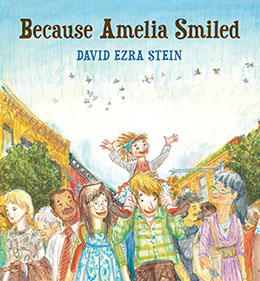 Because Amelia Smiled written and illustrated by David Ezra Stein (Candlewick, 2012), is about connection, the connections we know of and the connections that we make without knowing. “Because Amelia smiled coming down the street, Mrs. Higgins smiled, too. She thought of her grandson, Lionel in Mexico and baked some cookies to send to him. Because Mrs. Higgins baked cookies Lionel ate one of the cookies. He decided to share the rest with his class…” The chain of actions started by Amelia’s smile ripples out around the world as each recipient is moved to teach a song, or record a video, or add steps to a dance recital, or dance a brother to sleep, or give a free music concert. That concert inspires Gregor the ex-clown to write to his old friend Phyllis and propose marriage. Phyllis is so happy she throws roses from a high wire. And this leads to a video that is seen by a pizza maker who knits a rose scarf. And that leads to Pigeon Man Jones letting out his pigeons. And Amelia sees them and smiles again. This funny and sweet story reminds us that our acts can have a consequence, and that consequence can lead to something we will never be aware of. It reminds us that, as David Ezra Stein says, “…we are connected. To people we love. To people we don’t even know.”
Because Amelia Smiled written and illustrated by David Ezra Stein (Candlewick, 2012), is about connection, the connections we know of and the connections that we make without knowing. “Because Amelia smiled coming down the street, Mrs. Higgins smiled, too. She thought of her grandson, Lionel in Mexico and baked some cookies to send to him. Because Mrs. Higgins baked cookies Lionel ate one of the cookies. He decided to share the rest with his class…” The chain of actions started by Amelia’s smile ripples out around the world as each recipient is moved to teach a song, or record a video, or add steps to a dance recital, or dance a brother to sleep, or give a free music concert. That concert inspires Gregor the ex-clown to write to his old friend Phyllis and propose marriage. Phyllis is so happy she throws roses from a high wire. And this leads to a video that is seen by a pizza maker who knits a rose scarf. And that leads to Pigeon Man Jones letting out his pigeons. And Amelia sees them and smiles again. This funny and sweet story reminds us that our acts can have a consequence, and that consequence can lead to something we will never be aware of. It reminds us that, as David Ezra Stein says, “…we are connected. To people we love. To people we don’t even know.”
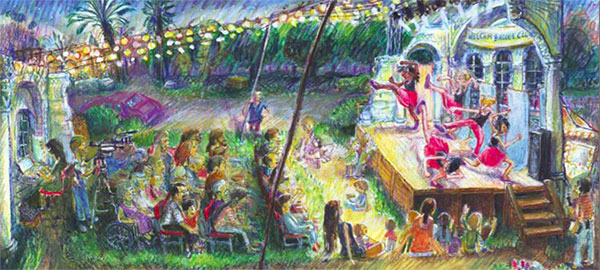
Phyllis: I love the circularity of this story, of how it begins with Amelia smiling and ends with Amelia smiling as the chain of action and consequence moves from New York to Mexico to England to Israel to Paris to Italy back to New York again. Our world is both big and small. Why not smile? Who knows how far a smile will travel and who it will connect us to?
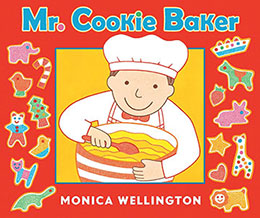 Mr. Cookie Baker, written and illustrated by Monica Wellington (Dutton, 1992), tells us of a day in the life of Mr. Baker, cookie-maker. He rises early, bakes and decorates his cookies. Children come to buy the beautiful cookies until he is sold out. He gives himself the last cookies. “Good Night!” If this simple and satisfying story makes you hungry for cookies, you are in luck because Monica Wellington has provided recipes for four kinds of cookies. One of the gifts of this story might be the fun of baking cookies with a friend. This book, like the good acts in the above story, ripples out into our real worlds.
Mr. Cookie Baker, written and illustrated by Monica Wellington (Dutton, 1992), tells us of a day in the life of Mr. Baker, cookie-maker. He rises early, bakes and decorates his cookies. Children come to buy the beautiful cookies until he is sold out. He gives himself the last cookies. “Good Night!” If this simple and satisfying story makes you hungry for cookies, you are in luck because Monica Wellington has provided recipes for four kinds of cookies. One of the gifts of this story might be the fun of baking cookies with a friend. This book, like the good acts in the above story, ripples out into our real worlds.
Jackie: This is such a simple book, gaily illustrated with bright colors, and yet it’s an act of grace, the baking of cookies for children to eat — and one for Mr. Baker, too. My grown children, their aunt, and I spent an afternoon last winter baking sugar cookies, frosting, and decorating them with colors seldom seen on cookies, then sharing them with family and eating them in our own celebration of cookies and cookie art.
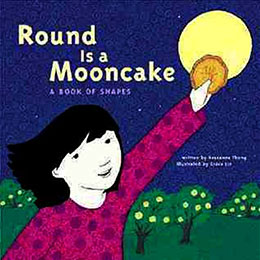 Round Is a Mooncake, written by Roseanne Thong and illustrated by Grace Lin (Chronicle, 2000), celebrates the shapes in our world and starts with a mooncake a traditional Chinese dessert, eaten during the Mid Autumn Festival. Mooncakes are always round. The “cake,” made with flour and a sugary syrup, is wrapped around a sweet filling, which is sometimes wrapped around an egg yolk. This book starts with round mooncakes and goes through the traditional shapes, making reference to many aspects of Chinese culture — including rice bowls, jasmine tea, tofu, radish cakes, dim sum, and inking stones. Grace Lin’s colorful illustrations call us into the story to watch as the narrator practices letters, purchases rice, or watches a puppet show. This is a lovely book that will have readers looking for shapes in their own lives and kitchens.
Round Is a Mooncake, written by Roseanne Thong and illustrated by Grace Lin (Chronicle, 2000), celebrates the shapes in our world and starts with a mooncake a traditional Chinese dessert, eaten during the Mid Autumn Festival. Mooncakes are always round. The “cake,” made with flour and a sugary syrup, is wrapped around a sweet filling, which is sometimes wrapped around an egg yolk. This book starts with round mooncakes and goes through the traditional shapes, making reference to many aspects of Chinese culture — including rice bowls, jasmine tea, tofu, radish cakes, dim sum, and inking stones. Grace Lin’s colorful illustrations call us into the story to watch as the narrator practices letters, purchases rice, or watches a puppet show. This is a lovely book that will have readers looking for shapes in their own lives and kitchens.
Phyllis: Along with traditional objects such as a name chop, Thong includes a variety of objects that any child might see around her, including a mobile phone, a pizza box, and the moon, along with encouragement to seek out other shapes in our surroundings. Brightly colored art is its own invitation into this book.
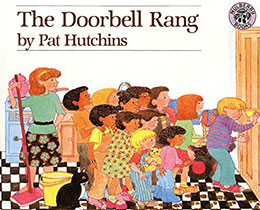 Kitchen is the setting for The Doorbell Rang, written and illustrated by Pat Hutchins (Greenwillow, 1986). Victoria and Sam are “starving” when Mom gives them a plate of twelve cookies — six each. The kids say these cookies look and smell as good as Grandma’s cookies. But Mom says, “Nobody makes cookies like Grandma.” Before they can take a bite the doorbell rings — Tom and Hannah from next door. Now it’s three cookies each. They all agree the cookies look and smell as good as Grandma’s. But Mom says, “Nobody makes cookies like Grandma.”
Kitchen is the setting for The Doorbell Rang, written and illustrated by Pat Hutchins (Greenwillow, 1986). Victoria and Sam are “starving” when Mom gives them a plate of twelve cookies — six each. The kids say these cookies look and smell as good as Grandma’s cookies. But Mom says, “Nobody makes cookies like Grandma.” Before they can take a bite the doorbell rings — Tom and Hannah from next door. Now it’s three cookies each. They all agree the cookies look and smell as good as Grandma’s. But Mom says, “Nobody makes cookies like Grandma.”
The doorbell continues to ring until the kids are twelve around the kitchen table — one cookie each. But the doorbell rings again. Fortunately, it’s Grandma! With a tray of cookies. And nobody makes cookies like Grandma!
Jackie: Of course, I love the repetition of this story and the poor mom continually mopping the floor that is continually being tracked on. But, the best part of this story for me is at that doorbell ringing when Ma suggests the twelve kids quickly eat the twelve cookies before they open the door. “We’ll wait,” said Sam. He’s willing to share with whoever is at the door, even though it could mean he gets only a part of a cookie. That action is so subtle but so important. And who cannot be happy to see Grandma with a tray of her unparalleled cookies. This story is a sure-fire favorite.
Phyllis: I came across this book in a Little Free Library and fell in love. I love Ma’s modest assertion that no one makes cookies like Grandma, the welcoming in of all who ring the doorbell, and I, too, love that Sam is willing to wait to share cookies with whoever else is coming. Along with the subtle insertion of math (2 children = 6 cookies each, 4 children = 3 cookies each, and so on), I love the way the art adds its own little stories such as the pots on the stove emitting more and more steam from spread to spread and the cat, unruffled by the hubbub as she moves from lap to lap, ending up contentedly on the empty cookie platter.
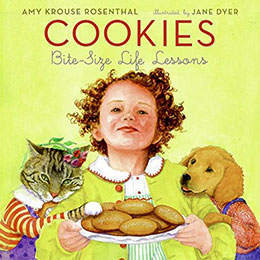 The last book by one of our favorite writers, Amy Krouse Rosenthal, is Cookies: Bite-Size Life Lessons (illustrated by Jane Dyer, HarperCollins, 2006). This is not a story but a dictionary of actions and emotions, defined in terms of cookies. For example:
The last book by one of our favorite writers, Amy Krouse Rosenthal, is Cookies: Bite-Size Life Lessons (illustrated by Jane Dyer, HarperCollins, 2006). This is not a story but a dictionary of actions and emotions, defined in terms of cookies. For example:
“Co-operate means you add the chips while I stir.” Or “Modest means you don’t run around telling everyone you make the best cookies even if you know it to be true.” “Fair means you get a bite. I get a bite… Unfair means you get a bite and now I get the rest.” Diverse children and clothed cats, dogs, and rabbits — all kinds of rabbits — illustrate terms such as greedy, generous, pessimistic, optimistic, polite, honest, even open-minded. “I’ve never seen cookies like that before but, sure, I’ll try one.” There’s something wonderfully creative about illustrating traits and emotions with cookies. We can’t always understand our feelings, but we can all understand cookies. And cookies are non-threatening. I know some might say this is a didactic book, or too adult-oriented to be fun for kids. That could be true. I can see worth in those arguments. And I’ve never read it with a child. I’d like to. Maybe even act it out with a plate of cookies between us and see what happens.
Phyllis: I love the idea of using a plate of cookies to act out the lessons: life imitating art. It may be that this book was aimed more at grown-ups, but what’s against a picture book for grown-ups as well as children, especially one so delicious with such enchanting art? And what’s against cookies? Nothing!
Reading these various cookie stories may spark cookie memories, may spark cookie baking. Either sharing the memories or sharing the baking will keep us warm on chill November days.

Great to see all of these wonderful books being highlighted. David Ezra Stein actually started Because Amelia Smiled when he was in class at Parsons. Even as an unfinished first draft, that story was clearly the beginning of a brilliant career. He’s a rare talent and so gifted at capturing big ideas and big emotions for little readers.
I love that you showcase books thematically and not just the new arrivals.
This column is always a delight to read.
Thanks for being a part of this book – and cookie – loving community. We’re honored to have you here.